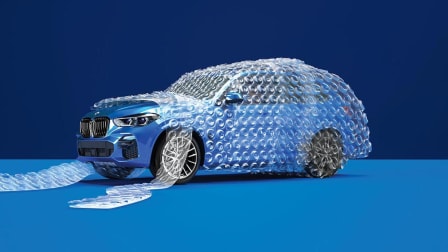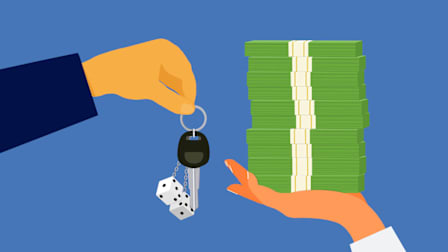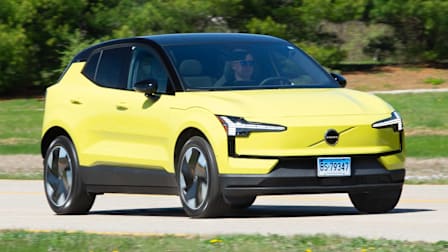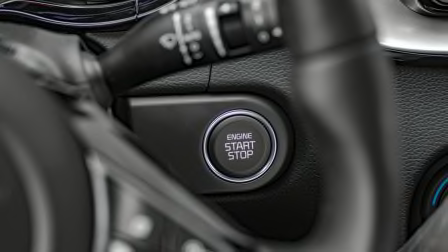Street Parking Survival Guide
From finding the best parking spots to protecting your car’s parts, here’s what all street parkers need to know
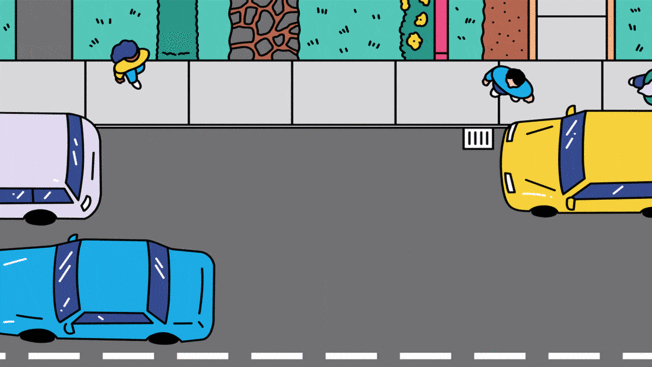
Street parking leaves your vehicle vulnerable to the elements and to other people, but it’s unavoidable for the 35 percent of American households without a garage or carport, or the hundreds of dollars a month it can cost to park in a public garage. My friend Todd Rogers did the math and found that it’s more economical for him to pay $45 parking tickets once a week than $300 a month to garage his car in his Brooklyn neighborhood.
- Parking Tips
- How to Take Care of Your Car
- How to Protect Your Car From: Damage Theft
I’m no car expert, but after 20 years of roughing it on the street, thousands of dollars spent to repair sideswiped doors, smashed headlights, dinged bumpers, dented hoods, punctured tires, and broken windows, plus piles of tickets (all paid, of course), I am a street-parking survivor and more than qualified to write this guide. These tips are drawn from my experiences, as well as those of car experts and other street parkers who, like me, learned the hard way so you don’t have to.
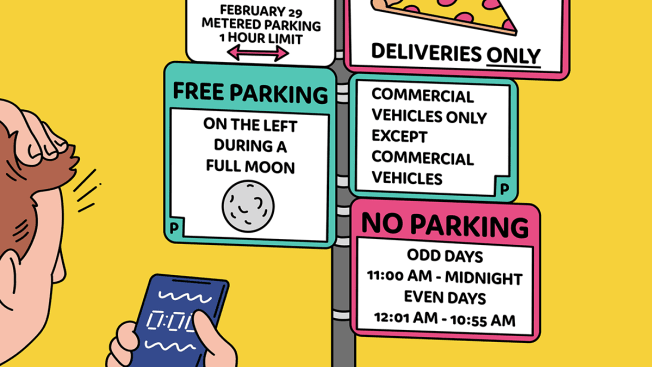
Illustration: Sam Island Illustration: Sam Island
Parking Smarts
You can pray to the parking gods all you want, but having some street-parking smarts goes a long way in avoiding damage, tickets, and theft. “I am a fan of parking strategically,” says Chaya Milchtein, automotive educator and author of “Mechanic Shop Femme’s Guide to Car Ownership.” “Consider it like defensive driving.” That means thinking ahead and taking steps to avoid theft and damage to your vehicle.
Choose corner spots. Parking in the first or last spot on the block is ideal because it prevents being bookended by other cars, Milchtein says. That means less chance of being blocked into the spot and less likelihood that both bumpers get damaged by other parkers. There will often be a fire hydrant there, so know your city’s rules regarding how far away your car must be parked (usually about the length of another vehicle).
Go toward the light. “Parking in a more brightly lit main street area helps lower the risk of vandalism or theft,” Milchtein says. Parking in front of an occupied building can also be a deterrent to thieves and vandals.
Parallel park like a pro. A prime parking spot doesn’t matter if you can’t get your car into it. Learn and practice proper parallel parking techniques or take a refresher driving course. Your insurance company might even reduce your rate for taking an approved safety-focused class. If you’re buying a new car and parallel parking just isn’t your forte, get a model with a 360-degree camera, parking sensors, and a tight turning radius. Some cars, such as the 2024 BMW X1 and the 2024 Toyota Prius, can even automatically park the car for you.
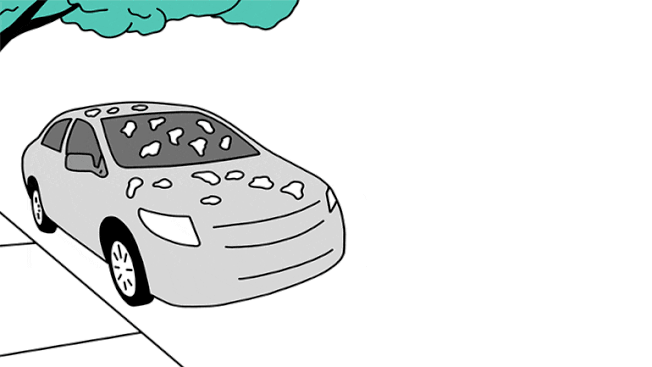
Illustration: Sam Island Illustration: Sam Island
Avoid parking under trees. Bird poop and tree sap are acidic and will damage the paint on your car. If you get dumped on by winged vandals, be sure to clean it off quickly to avoid lasting paint damage. Wet, heavy snow can also cause branches to break and fall on your car.
Park upstream. If flooding is in the forecast and you can plan ahead, consider finding a garage for the day or heading to higher ground to protect your vehicle. If water reaches the floor of your car, that can mean trouble. In a matter of minutes, a flash flood had the floor mats in my mother-in-law’s Mercedes-Benz floating when she parked on the street to attend a class. The insurance company totaled her flooded sedan because of electrical damage. “I relive my decision to park in that spot every time it rains,” she says. “Especially since it would have been just as easy to snag a spot on higher ground a few blocks away.”
Have some snow sense. In regions where it snows a lot, keep a snow shovel in the car—you’ll need it to dig out after the street plows bury your car or to turn a snow mound into a parking spot. But also know, if you toss that snow into the street or onto the sidewalk, you could end up with a ticket.

Illustration: Sam Island Illustration: Sam Island
Car Care
The elements can be brutal to cars, whether it’s UV radiation from the sun, acid rain, smog, bird droppings, bug guts, salt, or tree sap. Each of these environmental factors can eat through your paint and eventually lead to oxidation, corrosion, and, ultimately, rust. Being proactive is your best protection.
Get a car wash. “Ideally, you should wash your car every two weeks, especially during the winter if you live in a snowy region,” Milchtein says. “Once a month at the very least.” Salt and acid rain are major corrosives, but dirt, debris, and other air pollutants can also damage your car’s clear coat, the layer of transparent paint used to protect the color coat and primer coat from UV rays, oxidation, and environmental contaminants such as acid rain, tar, and salt.
Protect your paint job. Spray a lubricating metal conditioner on the car to prevent rust and corrosion. Milchtein recommends Corrosion Free Rust Cure Formula 3000, which is safe for paint, rubber, plastic, vinyl, and the environment.
Spot treat. Keep a roll of shop paper towels and tree-sap or bug-and-tar remover specifically made for cars (available at auto parts and hardware stores) in the trunk. Use both when you spot bird poop, bug guts, or tree sap—all of which eat away at your car’s finish.
Take cover. A snow cover or blanket can help protect your windows from hail damage and save you the trouble of scraping frost when the temperature drops below freezing.
Beware of dead batteries. Car batteries can lose charge if you don’t drive 20 to 30 minutes at least once a week. If you park outdoors, use your car infrequently, or don’t have access to a power source, solar-powered battery maintainers can come in handy. They help offset any natural battery discharge, so you won’t need a jump start the next time you need your car.
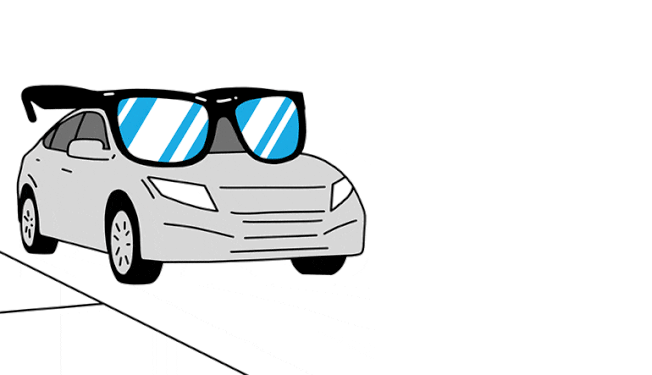
Illustration: Sam Island Illustration: Sam Island
Throw some shade. Constant exposure to sunlight can crack or tear your dashboard and leather seats. Use a windshield sunshade to help block rays and a leather conditioner to keep your seats supple.
Don’t do repairs on the street. “In many jurisdictions, it’s not legal to work on your car when you’re parked on the street,” Milchtein says. If you decide to take your chances anyway, be sure to do it in a safe spot away from traffic, like an alleyway, a parking lot, or a public park. There are also shops that rent out stalls and tools for people to make car repairs.
In addition to buying or renting a set of basic portable hand tools, you can use an inexpensive mover’s blanket to keep the ground clean and a bunch of towels to keep your body clean. Stick to simple jobs, such as changing your brakes, air filters, tires, or spark plugs. If you’re not super-savvy about doing these things, you can search on YouTube for a tutorial, channels like Eric the Car Guy, ChrisFix, and 1A Auto.
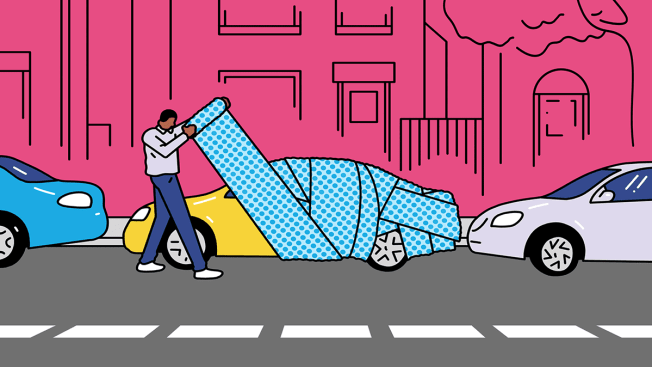
Illustration: Sam Island Illustration: Sam Island
Damage Control
We’ve already talked about the harm nature can do to your car, but other people and drivers can do even more damage. Here’s what our panel found works to help protect your car and what’s a waste of money.
No matter what measures you take, stuff happens, so make sure you’re well protected by insurance. Mark Friedlander of the Insurance Information Institute says it is essential that 24/7 street parkers purchase comprehensive auto coverage, an option that covers all noncollision losses, such as fire, wind, hail, flood, theft, vandalism, and cracked windshields.
Consider a bumper guard. A bumper guard is designed to be flipped out of the trunk to protect the back bumper from other cars after you’ve parked. It does its job but can sometimes leave its own scratches and marks on the bumper, especially if you don’t stow it before you drive off and it ends up flapping against your bumper.
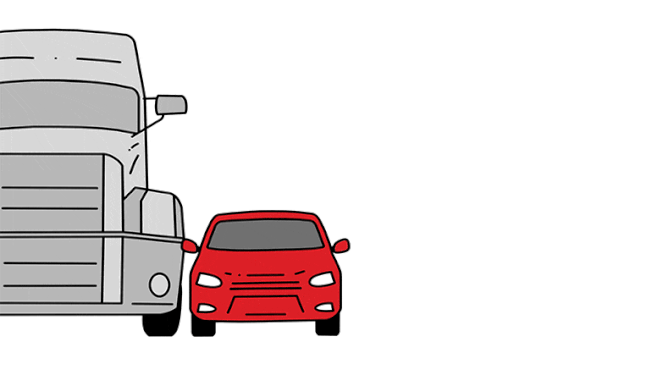
Illustration: Sam Island Illustration: Sam Island
Fold-in side mirrors. “When I lived in New York City, I always folded in my side mirrors,” Milchtein says. “The streets are narrow, people don’t drive very thoughtfully, and mirrors get broken all the time.” Thieves are also less likely to target a car when the side mirrors are folded in. David Glawe, president and CEO of the National Insurance Crime Bureau (NICB), says folded mirrors could suggest the vehicle is secured because some vehicles’ mirrors automatically fold in when the car is locked.
Take everything with you. Don’t leave anything in the car, even if it has little or no value. The cost to repair a shattered window is what you’re trying to avoid here. (Almost everyone I spoke with for this article has had their car broken into.) Some people go so far as to leave their empty glove compartments and the center console open to ward off break-ins. If you keep a gun in the car, make sure it’s locked in a gun safe or secured with a cable lock, as reports of guns stolen from vehicles are on the rise. Researchers at Everytown, a gun safety advocacy group, found that a decade ago, less than a quarter of all gun thefts were from cars; in 2020, over half of them were.
360-degree dash cams can help in case of crashes. When filing a police report or an insurance claim, dash cams can document your story. “Get a forward and reverse dash cam so you can see in front of you and behind you,” Milchtein says. Some more expensive dash cams will activate when they detect motion (as when another driver rams your car) and will hopefully capture the license plate number of the other car in a crash. A possible downside: Dash cams may also be tempting to thieves.
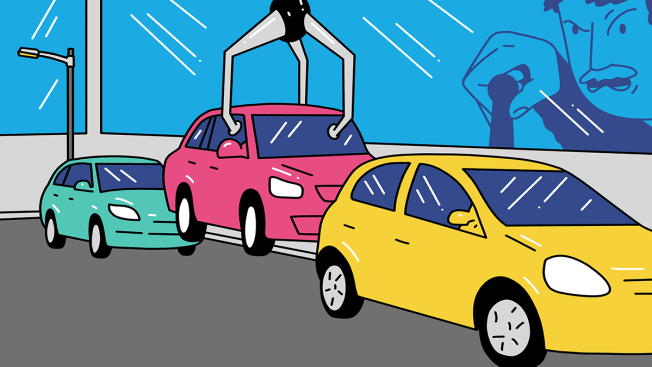
Illustration: Sam Island Illustration: Sam Island
Thwart Thieves
Car thefts increased by 9.2 percent in 2020, according to a preliminary report by the NICB, with more cars stolen than in any other year in the past decade. The NICB says the economic downturn, loss of juvenile outreach programs, and limited public safety resources are probably contributing factors. Car thieves are opportunistic and look for vehicles that are easy to steal, so making it as difficult and slow as possible for them to boost your car could give you an advantage. Friedlander says installing anti-theft devices might qualify you for a 15 to 20 percent discount on the optional comprehensive portion of your auto insurance policy too.
Know if you’re driving a target. Take extra precautions if your car is listed on the NICB’s annual Hot Wheels report, which ranks the 10 most frequently stolen makes and models. Theft claims were nearly twice as common for Hyundai and Kia vehicles as a group than for all other manufacturers, according to a recent report from the Highway Loss Data Institute, which tracks insurance claims.
“Apparently, [older model] Jeep Cherokees are one of the easiest cars to steal because it’s easy to punch the ignitions,” Jen Martinez says. Her 2000 Jeep was stolen on Labor Day in 2020 with nothing but a screwdriver jammed into the ignition. “When I got my car back, I had to start it with the same screwdriver they used to steal it.” (In fact, Labor Day is the second most common holiday for car theft, after New Year’s Day, according to the NCIB 2019 Holiday Theft Report.)
Also a regular on that list is the Toyota Corolla, not exactly a sexy car, but its parts are in high demand. Rogers had his Corolla stolen in Syracuse, N.Y., and when it was recovered weeks later, all kinds of parts were missing and the hatchback had been replaced. According to the National Highway Traffic Safety Administration, vehicle thieves can make two to four times a vehicle’s worth by selling its individual parts.
Install a visible or audible deterrent. Alarms that disable the car, steering wheel locks such as the Club, and wheel locks communicate to thieves that your car is protected. None of these is 100 percent effective, but Milchtein says their presence alone can deter most thieves, who will often move on to something easier to steal. The first thing Martinez did when she got her Jeep back from the police? “I went and bought a Club,” she says. “I put it on every day.”
Stop thieves in their tracks (or at least slow them down). Immobilizing devices, including kill switches (hidden devices that inhibit the flow of electricity or fuel to the engine until a hidden switch or button is activated), smart keys (the car can’t start without them), and brake locks, can prevent thieves from driving off in your car. In hindsight, Mike Massucco of Oakland, Calif., says he should have protected his vintage Toyota pickup truck, which he knew people were eyeing before it was stolen. “Every couple of months, I’d find notes on the truck asking if I wanted to sell it,” he says. “I didn’t have a kill switch on it, so anyone with a slim jim and screwdriver could have stolen it.” (A slim jim, a locksmith’s tool, is a thin strip of metal with a hooked end that is slipped between a car’s window and the rubber seal to unlock the door.)

Illustration: Sam Island Illustration: Sam Island
Track your car. There are devices that alert you if your vehicle has been stolen and track its whereabouts. Some can also disable your car. “Tracking devices are very effective in helping authorities recover stolen vehicles,” says the NICB’s Glawe. “Some systems employ telematics, which combine GPS and wireless technologies to allow remote monitoring of a vehicle. If the vehicle is moved, the system will alert the owner and the vehicle can be tracked via computer.” You can buy a system on Amazon for about $250 (some require subscription services for about $10 to $15 per month).
Don’t leave your car running unattended. I once mistakenly left my Prius parked and running on a Manhattan street overnight because it was pouring rain, I was in a rush, and I didn’t hear the motor running. I had the fob on me and didn’t realize the car was on until the next day, when I miraculously found it unstolen. Yes, I know how lucky I am: Half of the 6,858 vehicles stolen in New York City in 2020 were taken while they were running.
I’ve also been guilty of leaving my car running to warm it up in the winter, aka “puffing.” Lucky again, because many cars are stolen this way. It has become such a problem that it’s now illegal to leave your car running and unlocked in many states. It’s not only bad for the environment but also unnecessary. According to CR’s chief mechanic, John Ibbotson, your engine needs only 10 to 15 seconds to warm up before you can drive off.
Never leave your keys in the car. About half of vehicle thefts happen when doors are unlocked and keys or fobs are in the car. “The beauty of a key fob is that you don’t need it in your hand to start the car,” Milchtein says. “The downside is you don’t need to have it in your hand to turn off the car, either.” The best thing to do is never remove the fob from your pocket or your bag.
Don’t use your fob to lock the car. A growing opportunity for car thieves is breaking into cars by hacking the keyless entry systems, which use low-power radio signals. “These signals can easily be intercepted or amplified by tech-savvy thieves to trick the car’s internal computer system into thinking the fob is in contact with the door or ignition when it’s actually somewhere else,” Friedlander says.
Leyba says that clicking the buttons on your fob amplifies the signals and makes it easier for hackers to intercept them, especially when you click repeatedly to lock it. To reduce the chances that your fob will be hacked, use the switch inside the car or your key to lock the doors. Glen Rockford, CR’s Digital Lab privacy program manager, says even using the sensor on the door handle to lock and unlock your door is better than using the key fob (if your car has this capability) because a hacker would have to be much closer to sniff out your key fob’s radio signal (think 3 feet as opposed to 100 feet).
Don’t leave identifying information inside your vehicle. Imagine having your car stolen and your identity stolen too. Or being targeted at home. Keep a picture of your registration and insurance documents on your cell phone and keep all papers with your name, address, and other personal information at home. In August 2020, Sarah Noble’s Dodge diesel truck was stolen when her son took it to go fishing near Wellington, Colo. The police found and returned the truck three weeks later, but the thieves, knowing Noble’s address from the registration, stole the truck again that same night and months later used the title that was also in the car to sell it.
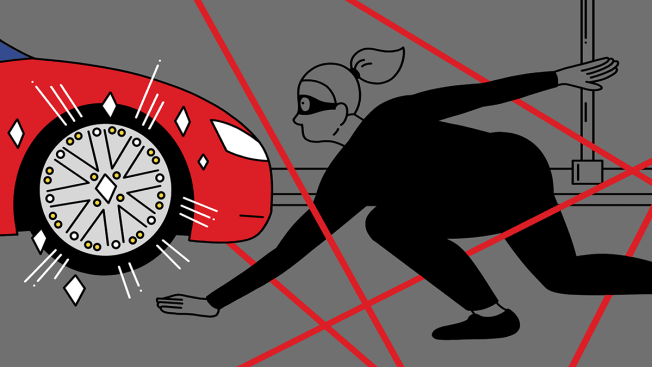
Illustration: Sam Island Illustration: Sam Island
Protect Your Car Parts
Thieves don’t need to steal your entire vehicle if the parts they want can be removed in minutes. But there are steps you can take to help protect certain parts.
Shield your wheels. You might want to get wheel locks to protect your tires from thieves. These locks (about $50 to $100 for a set of four) essentially replace one lug nut on each wheel with a lock, which requires a key to open. But like all anti-theft devices, wheel locks aren’t 100 percent effective—they just slow thieves down. “If somebody is going out of their way to steal your wheels, it’s likely that they will know how to break the locks,” Milchtein says. If your wheels are far from fancy, don’t bother with locks. Milchtein says they are a hassle if you lose the key—especially in the case of a flat tire. Geico suggests turning your wheels to a 45-degree angle when you park. The inner fender will likely get in the way of anyone trying to get the lug nuts off.
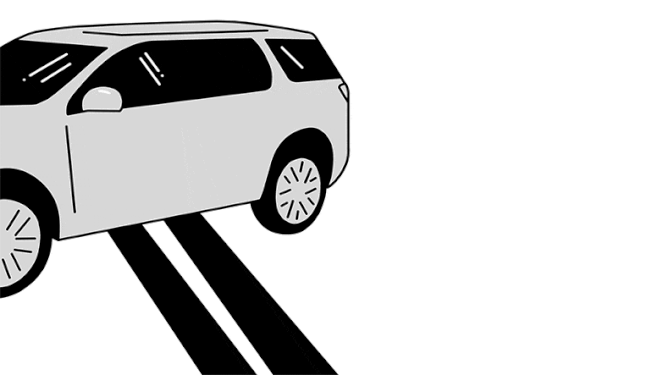
Illustration: Sam Island Illustration: Sam Island
Install a catalytic converter shield. Cap City Muffler in Sacramento, Calif., makes Cat Security shields to protect catalytic converters from thieves. It currently makes them for the most targeted vehicles: the Toyota Prius, Toyota Tacoma, Honda Element, Nissan NV200, and Chevrolet City, with more models coming. A shield costs $120 to $480, depending on the model. A local independent auto shop would charge about $350 to install it, which, when all put together, is still cheaper than replacing a catalytic converter, which could run you as much as $2,500.
Lock up your tailgate. Tailgates are easily damaged and easily removed. With new tailgates costing hundreds to more than a thousand dollars, it is no wonder they’re a commonly stolen auto part. A tailgate can’t be easily stolen unless it’s open, so keep it locked shut. Some trucks have integrated locks on the tailgates, but many don’t. An aftermarket tailgate lock costs about $25. A hose clamp around the pivot point of the tailgate is a low-cost option that can serve as a deterrent—again, not 100 percent theft-proof, but it could make the job just time-consuming enough to persuade the thief to move along.

















